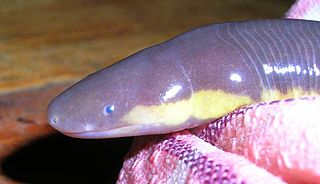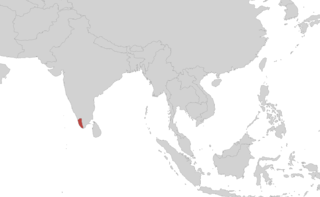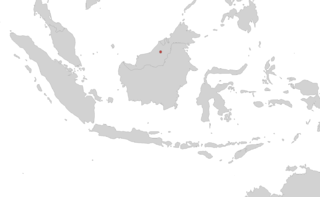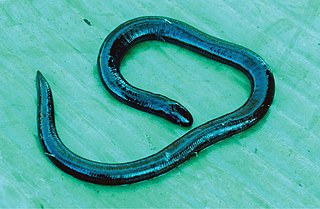
The Ichthyophiidae are the family of Asiatic tailed caecilians or fish caecilians found in South and Southeast Asia as well as southernmost China.

Ichthyophis beddomei is a species of caecilian in the family Ichthyophiidae. This species is distributed widely in the Western Ghats in southern India. The nominal species might be a composite of several cryptic species. It is also known as the yellow-striped caecilian, Beddome's caecilian, or Nilgherries caecilian.

Ichthyophis tricolor, the three-colored caecilian or Maddatorai caecilian, is an amphibian endemic to the Western Ghats, India. Its taxonomic status is unclear, including its relationship with Ichthyophis beddomei and the possibility of cryptic species.
Indotyphlus maharashtraensis is a species of caecilians described in 2004 by scientists of Bombay Natural History Society and the Natural History Museum, London. It is only the second species of Indotyphlus known to science, and only known from its type locality near Humbarli village, Satara District, in the Western Ghats of Maharashtra, India. Common names Humbarli caecilian, Maharashtra caecilian, and Konkan tail-less caecilian have been coined for it.

Ichthyophis orthoplicatus, also known as the Pattipola caecilian or brown caecilian, is a species of caecilian endemic to Sri Lanka. It is found in a range of natural and man-made habitats including evergreen forests, rubber and tea plantations, paddy fields, rural gardens and farms, wetlands, and cattle pastureland.

Ichthyophis pseudangularis is a species of caecilian endemic to Sri Lanka. It is found in a range of natural and man-made habitats: forests, rubber plantations, paddy fields, rural gardens and farms, wetlands, and pastureland.
Ichthyophis asplenius is a species of amphibian in the family Ichthyophiidae found in Malaysia and possibly Thailand. It is also known as broad-striped caecilian, Boven Mahakkam caecilian and Malayan caecilian. It is only known with certainty from Mahakam River and Matang Hunting Reserve Its natural habitats are subtropical or tropical moist lowland forests, rivers, intermittent rivers, plantations, rural gardens, heavily degraded former forest, irrigated land, and seasonally flooded agricultural land.
Ichthyophis atricollaris, also known as the Long Bloee caecilian, is a species of caecilian in the family Ichthyophiidae. It is endemic to Sarawak, Borneo (Malaysia), and only known from its imprecise type locality, "Long Bloee, Boven Mahakkam, Borneo". The type series were collected during the Nieuwenhuis expedition to Borneo and were deposited at the Rijksmuseum van Natuurlijke Historie, Leiden.
Ichthyophis biangularis, the angular caecilian or Metang caecilian, is a species of amphibian in the family Ichthyophiidae endemic to Borneo (Malaysia): it is only known from its type locality, Mount Matang in Sarawak, where the holotype was collected in 1872 by Alfred Hart Everett. New specimens were collected from the type locality only in 2009. In addition, one larval sample was collected from the same region and identified as likely Ichthyophis biangularis using genetic methods.

Ichthyophis billitonensis, the Billiton Island caecilian, is a species of amphibians in the family Ichthyophiidae endemic to the Belitung island, Indonesia. Known only from the holotype, this appears to be a small species, measuring 135 mm (5.3 in) in total length. Habitat requirements are unknown but it probably inhabits moist lowland forests. It may be threatened by habitat loss caused by opencast tin mining.

Ichthyophis dulitensis is a species of caecilian in the family Ichthyophiidae. It is endemic to Borneo and only known from near its type locality, Mount Dulit in northern Sarawak, Malaysia, after which it is named. Described by Edward Harrison Taylor in 1960, the holotype was collected by Charles Hose already in 1891. It is a poorly known species with uncertain taxonomic status. Common name Mount Dulit caecilian has been coined for it.

Ichthyophis elongatus, the elongated caecilian, is a species of amphibians in the family Ichthyophiidae endemic to Sumatra, including some nearby islands; however, whether these belong to this species is uncertain.

Ichthyophis hypocyaneus, the bantam caecilian, is a species of amphibian in the family Ichthyophiidae of caecilians, endemic to Indonesia. Until its rediscovery in 2000, it was known only from the 1827 type specimen.
The Upper Laos caecilian, Ichthyophis laosensis, is a species of amphibian in the family Ichthyophiidae. It is endemic to Laos and only known from a single specimen (holotype) collected from the imprecise type locality, "Upper Laos". Presumably a tropical moist forest species, nothing definite is known about its habitat or ecology.

Ichthyophis mindanaoensis, also known as Todaya caecilian or Mindanao Island caecilian, is a species of caecilian in the family Ichthyophiidae. It is endemic to the island of Mindanao, the Philippines.

Ichthyophis supachaii, or Supachai's caecilian, is a species of caecilian in the family Ichthyophiidae found in Thailand's provinces of Nakhon Si Thammarat and Trang, and possibly Malaysia.
Ichthyophis youngorum, the Doi Suthep caecilian, is a species of amphibian in the family Ichthyophiidae. It is known only from 10 adult and 13 larval specimens collected in 1957 by Edward Harrison Taylor. They were collected in the rainforest of Doi Suthep, near Chiang Mai, in Thailand, in a small valley at 1,200 m (3,900 ft) above sea level.

Ichthyophis nguyenorum is a species of caecilian in the family Ichthyophiidae. They were first found in Kon Plông District, Kon Tum Province, central Vietnam, in 2006, and formally described in 2012. The species is now also known from the Cat Tien National Park in the Lam Dong Province, southern Vietnam, and is presumed to occur more widely in suitable habitat in central and southern Vietnam as well as in eastern Cambodia.
Ichthyophis khumhzi, the Khumhzi striped ichthyophis, is a species of caecilian found in India. It has narrow and irregular lateral yellow stripes. It can attain lengths larger than 400 mm (16 in). Its head is V-shaped while short; the animal shows scales as far anterior as its collars. The species is named after Khumhzi village, where the specimens were first collected.

Ichthyophis kodaguensis, also known as the Kodagu striped Ichthyophis, is a species of caecilian in the family Ichthyophiidae. It is endemic to the southern Western Ghats, India. All confirmed records are from southern Karnataka state, although it is also reported from adjacent Kerala.













